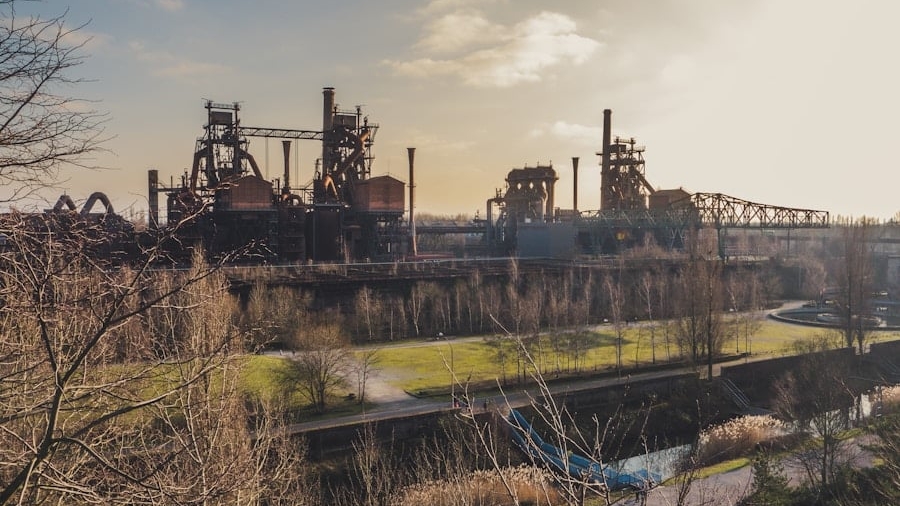Artificial Intelligence (AI) has emerged as a transformative force across various sectors, including environmental science. The integration of AI into environmental impact prediction represents a significant advancement in our ability to understand and mitigate the effects of human activities on the planet. By leveraging vast amounts of data and sophisticated algorithms, AI can analyze complex environmental systems, identify patterns, and forecast potential outcomes with unprecedented accuracy.
This capability is particularly crucial in an era marked by climate change, biodiversity loss, and increasing industrialization, where timely and informed decision-making is essential for sustainable development. The application of AI in environmental impact prediction encompasses a wide range of activities, from assessing the ecological consequences of industrial operations to predicting natural disasters. As industries expand and evolve, the need for effective environmental management becomes more pressing.
AI technologies, such as machine learning and neural networks, enable researchers and policymakers to simulate various scenarios, evaluate the potential impacts of different actions, and develop strategies that minimize harm to ecosystems. This article delves into the multifaceted role of AI in environmental impact prediction, exploring its applications, benefits, challenges, and ethical considerations.
Key Takeaways
- AI plays a crucial role in predicting environmental impact by analyzing data and patterns.
- Industrial activities can be analyzed using AI to assess their environmental impact and make informed decisions.
- AI enables efficient data collection and analysis, providing valuable insights for environmental impact prediction.
- AI can accurately predict environmental risks, helping industries to take proactive measures for mitigation.
- AI contributes to sustainable industrial practices by identifying areas for improvement and optimizing resource usage.
The Use of AI in Analyzing Industrial Activities
Monitoring and Compliance
AI provides tools that can monitor emissions, assess resource usage, and evaluate compliance with environmental regulations. For instance, AI algorithms can process data from sensors installed in factories to track real-time emissions of greenhouse gases and other pollutants. This data-driven approach enables immediate identification of anomalies or excessive emissions, allowing companies to take corrective actions swiftly.
Optimizing Industrial Processes
AI can enhance the efficiency of industrial processes by optimizing resource allocation and minimizing waste. Machine learning models can analyze historical production data to identify inefficiencies and suggest improvements. Predictive maintenance powered by AI can forecast equipment failures before they occur, reducing downtime and preventing unnecessary resource consumption.
Towards a Sustainable Future
By integrating AI into their operations, industries can not only improve their bottom line but also contribute to a more sustainable future by reducing their environmental footprint. AI-driven solutions can help industries transition towards a more environmentally friendly and sustainable future.
Data Collection and Analysis with AI

The effectiveness of AI in environmental impact prediction hinges on the quality and quantity of data available for analysis. Data collection methods have evolved significantly with advancements in technology. Remote sensing technologies, such as satellite imagery and drones, provide vast amounts of data on land use changes, vegetation cover, and water quality.
These data sources can be integrated with ground-based measurements to create comprehensive datasets that inform AI models. Once collected, data must be processed and analyzed to extract meaningful insights. AI excels in this area due to its ability to handle large datasets and identify complex relationships within the data.
For example, deep learning algorithms can analyze satellite images to detect changes in land use over time, such as deforestation or urban sprawl. By training these models on historical data, researchers can predict future trends and assess the potential impacts of various scenarios on ecosystems. This capability is invaluable for policymakers who need to make informed decisions regarding land management and conservation efforts.
AI’s Role in Predicting Environmental Risks
One of the most significant contributions of AI to environmental science is its ability to predict environmental risks associated with industrial activities.
For instance, machine learning algorithms can predict air quality levels based on factors such as traffic patterns, weather conditions, and industrial emissions.
This predictive capability allows authorities to issue warnings and implement measures to protect public health during periods of poor air quality. In addition to air quality predictions, AI can also be employed to assess risks related to water resources. By analyzing data on rainfall patterns, land use changes, and water consumption rates, AI models can predict the likelihood of water scarcity or contamination events.
This information is crucial for water management agencies tasked with ensuring sustainable water supply amidst growing demand and climate variability. Furthermore, AI can assist in predicting the impacts of natural disasters such as floods or wildfires by analyzing environmental conditions and historical disaster data, enabling communities to prepare more effectively.
AI’s Contribution to Sustainable Industrial Practices
The integration of AI into industrial practices has the potential to drive significant advancements in sustainability. By optimizing processes and reducing waste, AI can help industries transition towards more sustainable operations. For example, in the manufacturing sector, AI-driven analytics can identify opportunities for energy savings by monitoring energy consumption patterns and suggesting adjustments in real-time.
This not only reduces operational costs but also lowers greenhouse gas emissions associated with energy use. Moreover, AI can facilitate the development of circular economy practices by enabling better resource management.
For instance, companies can use AI to track the lifecycle of products and materials, ensuring that valuable resources are recovered at the end of their useful life rather than being discarded. This shift towards circularity not only conserves resources but also minimizes environmental impacts associated with extraction and production processes.
Challenges and Limitations of Using AI in Environmental Impact Prediction

Despite its numerous advantages, the application of AI in environmental impact prediction is not without challenges. One significant limitation is the availability and quality of data. In many regions, especially developing countries, comprehensive datasets may be lacking or unreliable.
Inconsistent data collection methods can lead to gaps in information that hinder the accuracy of AI models. Furthermore, biases present in historical data can propagate through AI algorithms, resulting in skewed predictions that may not accurately reflect current or future conditions. Another challenge lies in the complexity of environmental systems themselves.
Ecosystems are influenced by a multitude of factors that interact in intricate ways. While AI excels at identifying patterns within data, it may struggle to account for all variables affecting environmental outcomes. For instance, predicting the impact of climate change on biodiversity requires an understanding of numerous ecological interactions that may not be fully captured by existing models.
As a result, there is a risk that reliance on AI could lead to oversimplified conclusions that do not adequately address the nuances of environmental dynamics.
Ethical Considerations in AI-Driven Environmental Impact Prediction
The deployment of AI in environmental impact prediction raises several ethical considerations that must be addressed to ensure responsible use of technology. One primary concern is transparency; stakeholders must understand how AI models generate predictions and the underlying assumptions driving these outcomes. Lack of transparency can lead to mistrust among communities affected by industrial activities or environmental policies based on AI predictions.
Additionally, there is a risk that reliance on AI could exacerbate existing inequalities if marginalized communities are excluded from decision-making processes informed by these technologies. Ensuring equitable access to data and technology is essential for fostering inclusive participation in environmental governance. Furthermore, ethical considerations extend to the potential consequences of erroneous predictions made by AI models; inaccurate forecasts could lead to misguided policies that harm ecosystems or communities rather than protect them.
Future Outlook: Advancements in AI for Environmental Impact Prediction
Looking ahead, advancements in AI technology hold great promise for enhancing environmental impact prediction capabilities. As computational power continues to grow and algorithms become more sophisticated, we can expect improvements in model accuracy and predictive capabilities. Innovations such as explainable AI (XAI) aim to make machine learning models more interpretable, allowing stakeholders to understand how predictions are generated and fostering greater trust in these technologies.
Moreover, the integration of AI with other emerging technologies—such as the Internet of Things (IoT) and blockchain—could revolutionize environmental monitoring and management practices. IoT devices equipped with sensors can provide real-time data on environmental conditions, which can be analyzed by AI models for immediate insights into potential risks or impacts. Blockchain technology could enhance data integrity by providing secure records of environmental data collection and sharing among stakeholders.
As we continue to grapple with pressing environmental challenges, the role of AI in predicting impacts will likely expand further. Collaborative efforts among researchers, industries, policymakers, and communities will be essential for harnessing the full potential of AI while addressing its limitations and ethical implications. By fostering a responsible approach to AI-driven environmental impact prediction, we can work towards a more sustainable future that balances industrial growth with ecological preservation.
In a related article discussing the impact of technology on daily life, Do Samsung Smartwatches Work with Rooted Phones? explores the compatibility of smartwatches with rooted devices. This article delves into the intricacies of using Samsung smartwatches with rooted phones, shedding light on the potential benefits and drawbacks of such a setup. As technology continues to advance, understanding the compatibility of devices becomes increasingly important in optimizing their functionality and efficiency.
FAQs
What is AI?
AI, or artificial intelligence, refers to the simulation of human intelligence in machines that are programmed to think and act like humans. This includes tasks such as learning, problem-solving, and decision-making.
How does AI predict the environmental impact of industrial activities?
AI can predict the environmental impact of industrial activities by analyzing large amounts of data, identifying patterns and trends, and making predictions based on this analysis. This can help in assessing the potential impact of industrial activities on the environment and in making informed decisions to mitigate negative effects.
What are the benefits of using AI in predicting environmental impact?
Using AI to predict environmental impact can lead to more accurate and reliable assessments, as well as faster and more efficient analysis of data. This can help in identifying potential environmental risks and in developing strategies to minimize negative impacts on the environment.
Are there any limitations to using AI in predicting environmental impact?
While AI can be a powerful tool for predicting environmental impact, it is important to note that it is not a substitute for human expertise and judgment. Additionally, the accuracy of AI predictions relies on the quality and quantity of data available for analysis.
How is AI being used in real-world industrial settings to predict environmental impact?
AI is being used in real-world industrial settings to predict environmental impact by analyzing data from various sources, such as sensors, satellite imagery, and historical records. This data is used to model and simulate the potential environmental impact of industrial activities, allowing for better decision-making and risk management.

